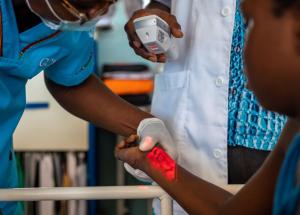Towards early cancer diagnosis in Senegal
Dakar – Asma* recalls the long journeys between her parents’ home in Mbour, a coastal city in western Senegal, and the Aristide Le Dantec Hospital in the capital Dakar, where she was being treated for leukaemia. It was a journey she came to know by heart. Diagnosed at age 16, she spent three long years in intensive treatment, followed by another five years of monitoring for any potentially life-threatening relapse.
“I was hospitalized continually for the first two months after following diagnosis,” she recounts. “After that, my mother would accompany me to hospital three or four times a week. We had to get up at 03:00 am to arrive early.”
Every year, an estimated 800 to 1200 children and adolescents in Senegal get cancer. Most deaths from childhood cancers are avoidable, as they result from late or erroneous diagnosis or due to poor access to care services. Early diagnosis and adequate care could raise survival rates from the most common types of cancers to more than 80%.
The Senegalese government, supported by its partners, is aiming to reverse the trend and save more lives. Some of the measures include a 50% government subsidy on childhood cancer treatment at the Aristide Le Dantec Hospital, reduced cost on some tests and surgeries, as well as provision of certain cancer medication at no cost.
To improve timely detection and prevent fatalities, World Health Organization (WHO) is supporting government efforts to raise public awareness of the importance of early detection.
“Early intervention saves lives,” says Dr Lucile Imboua, WHO Representative. “Most of the children lost to cancer die because of late detection. What’s lacking is communication, especially among parents and guardians. Communication is indispensable in helping those caring for a child to notice the signs of cancer, and to have the child examined as early as possible by a professional.”
Dr Fatou Diagne, the paediatric oncologist who treated Asma at Aristide Le Dantec Hospital and who specializes in prevention, diagnosis and treatment of childhood cancer, says she chose “this discipline as a way of serving my country – the need for human resources was dire.” She says her department has two paediatric oncologists, a general paediatrician and a team of three or four trainee doctors.
Between 2016 and 2020, the paediatric oncology department admitted 1134 children with cancer, 45% of them afflicted with one of three major types: leukaemia, nephroblastoma and retinoblastoma, concerning the blood, kidney, and eye, respectively.
WHO has also supported training for health workers in early diagnosis and care of the most common childhood cancers. Supporting the national health system to scale up communication around these issues, WHO has developed communication tools addressing the most common childhood cancers, with an emphasis on recognising warning signs and describing the steps to be taken. In November and December 2021, more than 400 communications products were produced for professionals and partners, while audio-visual content was produced for national broadcast.
Such support has extended to the highest levels as well, with notable impact.
“Our advocacy has helped make the fight against childhood cancer a top national priority,” says Dr Imboua, noting that paediatric oncology is now part of the national anti-cancer plan for 2022—2026. “This is a fundamental step forward in the fight against this major public health challenge, to ensure that more children are able to avoid preventable deaths.”
For Dr Diagne, such advancements are grounds for optimism. She notes with appreciation the support of the Franco-African Group of Paediatric Oncology, which provides multifaceted support to teams treating childhood cancer patients in African countries; and the Senegalese League Against Cancer, which provides medication support and subsidises certain radiotherapy treatments.
“What keeps me going is the satisfaction of seeing former patients survive adolescence and go on to become happy, productive adults,” she says. “I know that things are changing for the better – with the support of our partners, as well as the strong political will to promote paediatric oncology.”
She recalls Asma’s courage during treatment, and her relentless perseverance.
“I admire her tremendously. However much she endured, however difficult and intense her treatment, she pressed on to earn her school certificate at the start of treatment, followed by her baccalaureate near the end of chemotherapy,” she says. “Since then she’s become a regular in our department, spending time with the patients and using her own story to encourage them. She says no one can understand them better than she can.”
------------------------------------------------------
* Name has been changed
Communications Officer
WHO Regional Office for Africa
Email: dialloka [at] who.int (dialloka[at]who[dot]int)
Chargée de Communication
OMS Tchad
Email : coumbalay [at] gmail.com (coumbalay[at]gmail[dot]com)
